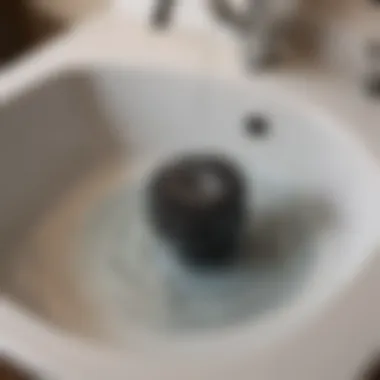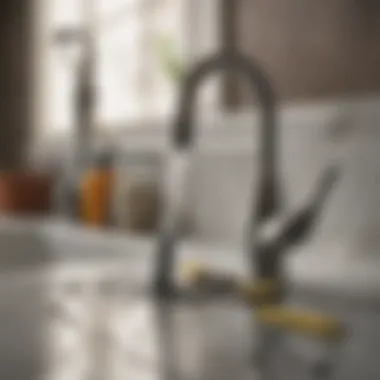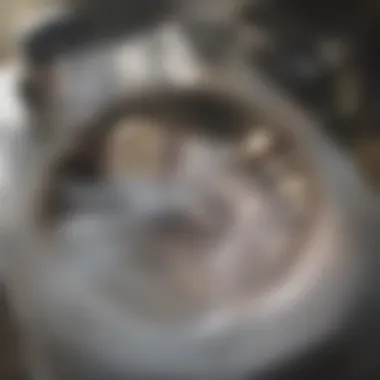Understanding and Resolving Hair Clogs in Sinks


Intro
Hair clogs in sinks are a common yet frustrating issue faced by many homeowners. They often lead to slow drainage, unpleasant odors, and potential plumbing damage. Understanding the causes and resolution methods for hair clogs is vital for maintaining a functional home. In this article, we will explore the intricacies surrounding hair clogs, including their causes, implications, and practical solutions.
Households with diverse lifestyles may experience these hair clogs differently, depending on various factors such as hair type, volume, and plumbing system. This comprehensive guide will delve into preventative measures homeowners can adopt. Moreover, it will provide insights tailored for those who appreciate the practical aspects of home maintenance.
Our focus will be on offering actionable advice for both do-it-yourself enthusiasts and those who may be inclined to seek professional assistance. By assessing the nuances of hair clogs, we can foster a deeper appreciation for effective plumbing management.
"Prevention and early intervention are key in managing household plumbing issues effectively."
In the following sections, we will discuss the causes of hair clogs, potential remedies, and best practices for ensuring that your sinks remain clear and functional. This knowledge will not only enhance your home but also save you from unnecessary expenses and headaches in the future.
Prolusion to Sink Clogs
The topic of sink clogs is relevant for homeowners and those interested in maintaining a functional plumbing system. When water doesn’t drain properly, it can lead to numerous problems, including unpleasant odors and potential damage to plumbing. Hair clogs, in particular, are a common issue that often goes unnoticed until it breaches a critical point, leading to a messy situation.
Understanding the mechanisms behind sink clogs is crucial. This section aims to define what sink clogs are and outline the common materials that cause them. By grasping these elements, readers will gain insight into why hair clogs occur, the potential impacts these can entail, and practical steps to mitigate them. This knowledge empowers individuals to take better care of their plumbing systems.
Defining Sink Clogs
Sink clogs occur when materials obstruct the flow of water in drains. These blockages can be small or extensive, causing varying degrees of problems. Hair, grease, soap residue, and food particles are typical contributors to sink clogs. Over time, these materials can accumulate, forming a barrier that restricts water movement.
Understanding what qualifies as a clog is essential. Clogs can happen gradually as materials build up or suddenly, often due to a large mass creating an immediate blockage. In either case, the result is often similar: backing up of water and difficulty in usage.
Common Materials Causing Clogs
Several materials are notorious for creating clogs in sinks, especially those involving hair. The following points highlight the most significant contributors:
- Hair: Typically, strands of hair intertwine with soap residue, creating dense clumps that catch more debris.
- Grease: When cooking, fats can solidify in pipes and trap other materials, restricting water flow.
- Soap Residue: Bar soap and other soaps can leave behind a film that attracts hair and other debris.
- Food Particles: In kitchen sinks, leftover food can quickly lead to blockages, particularly when large quantities are washed down the drain.
]](https://en.wikipedia.org/wiki/Drain_%28plumbing%29)Source > Understanding these materials helps in both identifying and preventing sink clogs effectively.
By recognizing the common culprits of sink clogs, homeowners can implement preventative measures to avoid future complications. Regular maintenance can significantly reduce the likelihood of clogs, saving time and costly plumbing repairs in the long run.
The Impact of Hair on Plumbing Systems
In understanding sink clogs, it is essential to recognize the significant role hair plays in the overall functionality of plumbing systems. Hair, often regarded as a common household nuisance, can create more complex issues if not dealt with properly. This section will explore how hair traps in drains and the implications of drainage design concerning hair-related clogs.
Why Hair Traps in Drains
Hair tends to get trapped in drains for various reasons. When we wash our hair or groom ourselves at the sink, loose strands can easily detach and begin their journey down the drain. The typical design of many sinks does not effectively prevent hair from entering pipes.
Moreover, hair can tangle with soap residue and other debris, creating a mass that quickly clogs the drain. This scenario is especially common in bathrooms, where hair shedding is prevalent. The resistance caused by the intertwined mess can lead to slow drainage and, eventually, a complete blockage.
Some common reasons why hair traps in drains include:
- The curvature of pipes, which creates potential catch points for hair.
- The presence of products like conditioners or gels that make hair more pliable, making it easier to form clumps.
- Lack of maintenance, which increases the likelihood of hair and other materials accumulating in the plumbing.
Persistent hair clogs can contribute to severe plumbing issues if left untreated.


The Role of Drainage Design
The drainage design in homes plays a crucial role in addressing the issue of hair. Many sinks utilize standard plumbing layouts that can easily become overwhelmed by hair accumulation. Poorly designed drainage systems fail to facilitate optimal flow, creating stagnation spots where hair can collect.
Factors to consider regarding drainage design include:
- Pipe Diameter: Narrow pipes can exacerbate clogs. Wider pipes allow for better flow and reduce hair buildup.
- Slope of Pipes: Properly inclined pipes help by encouraging efficient water flow, reducing the chances of hair settling in one spot.
- Type of Sink and Trap: Different sinks have varying trap designs. Some traps are more prone to blockages and require more frequent cleaning.
Given these design considerations, homeowners can implement changes to reduce the occurrence of hair clogs. Knowledge of how hair interacts with drainage systems can lead to more informed decisions regarding home maintenance and possible upgrades.
Ultimately, understanding the impact of hair on plumbing systems emphasizes the importance of prevention and maintenance. By contributing to better drainage design and taking preventive measures, homeowners can minimize the risk of clogs, ensuring a smoother and more effective plumbing system.
Identifying Hair Clogs
Understanding and identifying hair clogs is a critical part of effective plumbing maintenance. Homeowners often experience hair clogs without recognizing the signs early on. Detecting clogs sooner rather than later can save time, money, and frustration. Recognizing the symptoms of a clogged sink can lead to quicker solutions, reducing the impact on daily life.
Signs of a Clogged Sink
Several indicators point to the presence of a clog caused by hair. Some of the most common signs include:
- Slow Draining Water: If water takes longer to drain from the sink, it’s often the first noticeable sign that a clog is forming.
- Gurgling Noises: Strange sounds during drainage can indicate that air is trapped, pointing to a blockage.
- Foul Odors: A buildup of hair and other debris can lead to unpleasant smells emanating from the drain.
- Visible Hair Accumulation: Occasionally, hair may be visible in the sink or pop up around the drain.
Pay attention to changes in how your sink behaves. Early detection allows for swift intervention.
Diagnosing the Severity of the Clog
Once signs of a clog appear, it’s important to assess how severe the issue is. There are various methods to determine the severity:
- Observation: Begin by checking for water movement. If water drains slowly but eventually empties, a minor clog could be present.
- Testing the Drain Flow: Using a bucket, pour water into the sink. If it backs up dramatically, the clog is likely severe.
- Visual Inspection: Remove any visible hair or debris to see if drainage improves.
Assessing the severity of the clog is crucial for determining the best course of action. If the blockage is minor, DIY solutions may suffice. However, a more severe clog may require professional intervention.
Ignoring signs and allowing a clog to persist can lead to more serious plumbing issues. Always take note of changes in drainage to help maintain plumbing health.
Identifying and diagnosing hair clogs effectively can help prevent small issues from evolving into larger, costlier problems. Regular monitoring is advisable to maintain functional plumbing systems.
DIY Methods to Clear Hair Clogs
When it comes to managing hair clogs in sinks, understanding effective do-it-yourself methods can provide remarkable benefits. Not only do these approaches help in addressing immediate issues, they often save homeowners time and money compared to hiring a professional. Additionally, DIY solutions can be effective for less severe clogs, allowing individuals to maintain control over their plumbing issues.
It is essential to assess the severity of the clog before resorting to these techniques. Sometimes, a simple maintenance practice might suffice, while in other cases, a more hands-on approach may be necessary. Regardless, having a repertoire of DIY methods empowers homeowners with knowledge and skills that can prevent future plumbing troubles.
Using a Plumber's Snake
A plumber's snake, also known as a drain auger, is an invaluable tool in addressing hair clogs. It consists of a long, flexible metal coil that can maneuver through the plumbing system. This tool works by inserting the snake into the drain, allowing it to reach deep into the pipes to remove or break up clogs caused by hair and other debris.
To use a plumber's snake:
- Remove the drain cover: Ensure that you have clear access to the drain.
- Insert the snake: Carefully feed the snake into the drain until you feel resistance.
- Turn the handle: Rotating the handle helps the coil grab the clog.
- Pull back gently: Carefully remove the snake along with the debris.
Using a plumber's snake can be quite effective but requires some patience. If the clog persists, additional methods might be necessary.


Employing a Wet/Dry Vacuum
Another useful tool for clearing hair clogs is a wet/dry vacuum. This device can efficiently suction out water and debris, offering a powerful solution for stubborn clogs. A wet/dry vacuum is especially suitable for situations where traditional methods may not yield positive results.
To utilize a wet/dry vacuum:
- Create a seal: Fit the vacuum nozzle to the drain opening, ensuring there are no gaps.
- Set the vacuum to liquid mode: This allows for effective suction of liquids and debris.
- Turn on the vacuum: Allow it to run for several minutes to draw out the clog.
Take care when using this method, as it may require using multiple settings for best results. The vacuum's ability to manage both water and solid debris makes it an asset in any homeowner's toolkit.
Chemical Drain Cleaners
While DIY methods generally focus on physical removal of clogs, chemical drain cleaners can be effective in breaking down hair and gunk that may be blocking the pipes. However, caution is critical when choosing to use these cleaners, as they often contain caustic substances that can damage plumbing systems if used excessively.
Here’s how to use chemical drain cleaners safely:
- Select the right cleaner: Some products are formulated specifically for hair clogs.
- Follow instructions: Each product will have specific guidelines for quantity and method of use.
- Avoid mixing cleaners: Combining different chemical products can create dangerous reactions.
Always prioritize safety gear, such as gloves and goggles, when handling chemical cleaners. If clogs are recurrent despite this method, it may indicate a deeper issue within the plumbing system.
Effective DIY methods empower homeowners to tackle hair clogs confidently, enhancing their understanding of plumbing maintenance.
Preventative Measures Against Hair Clogs
Preventing hair clogs is crucial for maintaining the longevity of plumbing systems and avoiding costly repairs. By proactively addressing the potential for clogs, homeowners can save time, money, and frustration. These preventative measures not only protect plumbing infrastructure but also enhance the overall efficiency of drainage systems.
Installing Drain Covers
One effective method to prevent hair clogs is the installation of drain covers. Drain covers act as a barrier to stop hair and other debris from entering the drainage system. They come in various designs and sizes, making it easy to find one that fits your sink. Installing a drain cover is straightforward and usually requires no special skills or tools. Simply place it over the drain to block materials that may cause blockage.
Some benefits of drain covers include:
- Easy Cleaning: Most drain covers are removable and easy to clean. Regularly cleaning them can further prevent buildups.
- Variety of Styles: From mesh screens to decorative designs, homeowners can find a cover that matches their sink.
- Cost-Effective: Most drain covers are affordable and can prevent more expensive plumbing issues down the line.
Opting for a drain cover is one of the most straightforward yet effective methods to combat hair clogs. Regular inspections of the cover ensure its effectiveness.
Setting Regular Maintenance Routines
In addition to installing drain covers, establishing a regular maintenance routine can significantly reduce the risk of hair clogs. Homeowners should routinely check their sinks for early signs of blockage. Simple practices can enhance the life of plumbing systems.
Key aspects of a maintenance routine include:
- Weekly Inspections: Take a few moments every week to look for hair accumulation around the drain cover. Remove any visible debris.
- Flushing with Hot Water: Occasionally, run hot water down the drain to help dislodge any minor buildup that may be present.
- Use of Natural Remedies: Consider using a mixture of baking soda and vinegar monthly. This can help clean the pipes without harsh chemicals.
By embracing these practices, homeowners can create a consistent and proactive approach to plumbing maintenance.
"An ounce of prevention is worth a pound of cure." - Benjamin Franklin
Implementing effective preventative measures is a matter of diligence and awareness. With minimal effort, the likelihood of experiencing significant clogs can be greatly diminished.


When to Call a Professional
Understanding the right moment to enlist the help of a professional plumber is essential when dealing with hair clogs in sinks. DIY methods may work for minor clogs; however, there are instances where professional intervention is necessary. Recognizing these scenarios not only saves time but often prevents more significant plumbing problems down the line. Professional plumbers possess specialized knowledge and experience that can effectively address complex issues that typical household remedies cannot.
Assessing the Need for Professional Help
When confronted with a persistent hair clog, homeowners should assess the situation carefully. One of the primary indicators that it might be time to call in a professional is the duration and severity of the clog. If your attempts to unclog the sink using a plunger or drain snake yield no results after several tries, it is a strong sign that the clog is beyond simple fixes.
Moreover, any signs of water backing up or overflowing in multiple sinks or fixtures within a short time frame can indicate a more significant drainage issue. This kind of problem often requires professional diagnostic tools such as video inspection, which helps pinpoint the clog’s exact location and cause.
"Ignoring plumbing issues can lead to more extensive damage, ultimately escalating repair costs."
There are also considerations regarding the potential for structural damage to pipes within the plumbing system. Any unusual noises, such as gurgling or bubbling, from drains may suggest air trapped in the plumbing, often a symptom of a more profound blockage.
Understanding Plumbing Services
Plumbing services encompass a range of tasks that go beyond clearing clogs. Plumbers are trained to handle various issues, including leak detection, pipe repairs, hydro jetting, and routine maintenance. Familiarizing oneself with these services can provide clarity on what to expect when you decide to call a professional.
Additionally, many plumbing companies offer emergency services for urgent situations, which can be invaluable when a hair clog leads to flooding or serious water damage. When seeking a plumber, verify their credentials, read customer reviews, and inquire about their experience with similar issues.
The Long-Term Effects of Neglecting Hair Clogs
Ignoring hair clogs in sinks can lead to serious ramifications for both your plumbing system and your property value. These long-term effects are often overlooked until problems become severe. Understanding these consequences is essential for homeowners. It helps in making informed decisions about regular maintenance and timely interventions.
Structural Damage to Pipes
When hair clogs are left unchecked, they don't just cause temporary inconvenience. Gradually, they can lead to significant structural damage within the plumbing system. The blockage can create pressure build-up, which may cause pipes to burst or crack over time. Even minor leaks can go unnoticed initially, leading to serious water damage in walls or flooring. This kind of deterioration is often expensive to repair, and extensive plumbing replacements may be required.
- Signs of pipe damage include:
- Mold growth in areas surrounding the sink
- Water stains on ceilings or walls
- Unusual noises coming from the pipes
Regularly clearing hair clogs and inspecting the plumbing is a preventive measure that can save homeowners considerable expenses in repairs.
Impact on Property Value
Neglected hair clogs can also deteriorate your property value. If a home has ongoing plumbing issues, it will likely deter potential buyers. A history of plumbing failures signals underlying problems, making it problematic during home inspections.
- How plumbing issues affect property transactions:
- May lead to lower offers due to perceived risks
- Lengthens the time on the market for the property
- Possible demands for repairs before closing
Addressing hair clogs promptly contributes to maintaining not only functional plumbing systems but also the overall integrity of a property.
"Ignoring small plumbing issues like hair clogs can lead to extensive repair costs and property value loss."
The End
In summarizing the serious implications of hair clogs in sinks, we acknowledge the need for a robust understanding of this issue. Hair clogs are more than mere inconveniences; they can lead to significant plumbing problems and, ultimately, costly repairs. If not addressed swiftly, these blockages can exacerbate into structural damage within the piping system, affecting overall plumbing efficiency and property value.
Summary of Key Points
- Understanding Hair Clogs: Before one can address a clog effectively, it is crucial to understand what causes them. Hair is a frequent offender, often mixing with soap residue and other debris.
- Identification and Diagnosis: Recognizing the signs of a clog early can prevent further complications. Symptoms include slow drainage and unpleasant odors.
- DIY Solutions: Several methods exist for homeowners to tackle hair clogs, from using a plumber's snake to employing a wet/dry vacuum. Each method has its pros and cons depending on the severity of the clog.
- Preventative Measures: Installing drain covers and maintaining static cleaning schedules are effective strategies in minimizing the risk of future clogs.
- Professional Intervention: Knowing when to call in a skilled plumber is essential. In some cases, what starts as a minor blockage may require professional tools and expertise to rectify.
Final Thoughts on Maintenance
Maintaining your sink and preventing hair clogs is a continuous process. Regular inspections and cleaning can save homeowners significant time and expense over the long run. Take the time to implement daily preventative measures that will help ensure a smooth drainage system. Paying attention to any early signs of issues, coupled with informed decision-making regarding maintenance, empowers homeowners to keep their plumbing systems in optimal condition. Viewing plumbing care as a vital aspect of home management can lead to enhanced living environments and improved overall quality of life.















